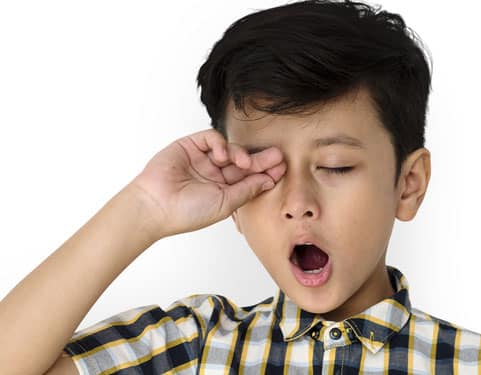Why Can’t This Kid Sleep?
- January 22, 2019
- The REACH Institute
- Child mental health, Pediatric primary care Sleep disorders,

Alana, age 17, comes in complaining that she is tired all the time and struggles to stay awake during school.
Or perhaps it’s six-year-old Miko, whose mother tells you that Miko avoids going to bed and often gets up in the middle of the night. Miko says he doesn’t feel sleepy, but his teachers say he is often inattentive and sometimes quarrelsome.
The most common sleep problems among young patients are these and other forms of insomnia or insufficient sleep, according to REACH faculty member Robert Kowatch, MD, a pediatric sleep expert and professor of psychiatry at Ohio State University Medical Center/Nationwide Children’s Hospital.
Fortunately, in most cases the diagnosis is straightforward, and treatment often consists of behavioral techniques for parents and cognitive behavioral therapy for adolescents.
Sleep problems can be divided into two broad categories, with some overlap:
- Excessive daytime somnolence, particularly in teens, is most often caused by insufficient sleep. Other less common causes include sleep apnea, narcolepsy, and sedating psychiatric medications.
- Insomnia, the inability to sleep, can be the primary diagnosis or may be secondary to other conditions, such as depression or restless legs syndrome/periodic leg movements during sleep.
The differences in diagnosis and treatment between teens and younger children can be fairly pronounced. For this issue, we asked Dr. Kowatch how to deal with children like Miko. Next month, he’ll tell you how to deal with teens like Alana.
“Younger children usually can’t tell you whether they have symptoms of disorders like snoring or restless legs syndrome,” said Dr. Kowatch. “But those issues are uncommon enough that we wouldn’t order a sleep study unless it’s indicated by factors other than insomnia.” One risk factor is a family history of restless legs or sleep apnea. Another is a diagnosis of autism spectrum disorder or ADHD, which are associated with higher incidence of periodic leg movements during sleep.
“For most children ages 2 to 6, the problem is behavioral,” said Dr. Kowatch. To assess the issue, pediatric primary care providers can ask parents about the child’s nighttime behavior.
- What time is bedtime?
- What is the pre-bedtime routine?
- Does the child follow this routine easily or disrupt it with “curtain calls” — just one more story or drink of water?
- Where does the child fall asleep — in his own bed or the parents’?
- Does the child stay in bed? How many times a night does she get up? What happens when she does?
“We call this a limit-setting sleep disorder,” said Dr. Kowatch. It’s the parents who need to set the limits. Dr. Kowatch recommends the process known as “Ferberizing,” after Richard Ferber, MD, author of Solve Your Child’s Sleep Problems. Parents of young children should:
- Stick to a consistent bedtime routine
- Try bedtime “fading”: Set as the temporary bedtime the hour at which the child can fall asleep naturally, even if that’s 10:30 pm. After a few nights, put the child to bed 15 minutes earlier. Repeat until the desired bedtime is reached.
- Gently but firmly put the child back into his own bed if he gets up in the night
- Use a sticker chart to reinforce the desired bedtime behavior
Children who feel anxious and want adult attention get what they need when caregivers lovingly impose consistent boundaries. “The parents need some coaching,” said Dr. Kowatch. “If necessary, you can refer them to a mental health specialist for sleep behavioral therapy. Many families need just a couple of sessions to develop these tactics.”
When the child’s behavior doesn’t fit the limit-setting profile, clinicians may want to assess risk factors for physical issues such as narcolepsy, apnea, and restless legs. Children with sleep apnea typically snore on most nights and are tired or irritable during the day. Clinicians may also screen for underlying mental health disorders such as depression or anxiety.
Next month: How to diagnose and treat the sleepy teen
Categories
- ADHD
- Anti-racism
- Anxiety
- Assessment & screening
- Autism
- Child mental health
- Coding
- Cognitive behavioral therapy
- College transition
- Culturally responsive
- Depression
- Eating disorders
- Foster care
- Grief
- High-risk children & youth
- LGBTQIA
- Medication
- Parents
- Patient communication
- Pediatric primary care
- School refusal
- Sleep disorders
- Suicide
- Trauma
- Show All Categories
Register for courses
“The REACH Institute Video Testimonial: Grizelda  ”
”
